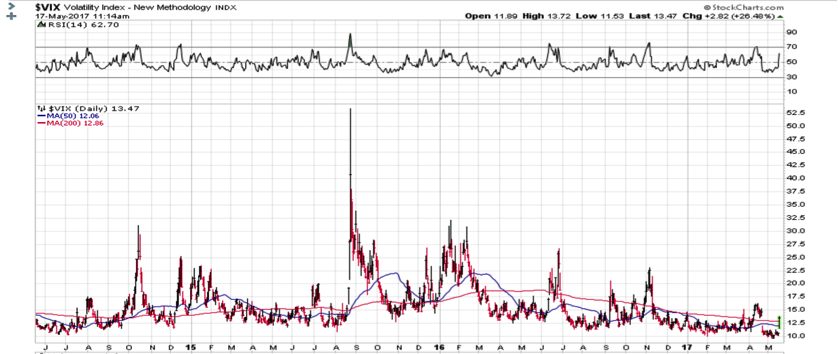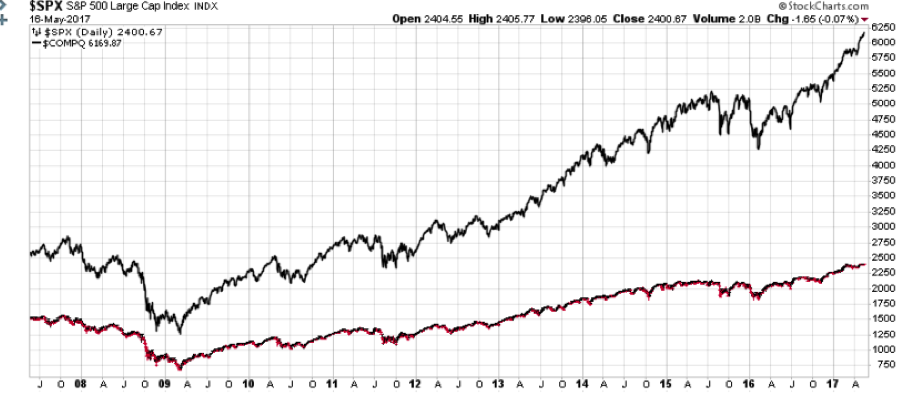Momentum for both stocks and bonds has carried into the second quarter, until today, as the market at last appears to have succumbed to an endless stream of turmoil pouring out of Washington DC. Even with today’s 300 point decline there is underlying strength in the US and global economy that has propelled stocks upward. The strength is not limited to the USA – global stock markets are doing well: Japan has recorded the longest streak of growth in eleven years, the European Union appears safe following the French election, and China’s Champions like Ali Baba and Baidu are achieving record or near record highs. In a surprise for perennial bond bears, rising short term interest rates have stalled, even reversed a bit, meaning the feared crash in fixed income investments (bonds, preferred stocks, utilities, REIT’s and BDC’s) has not materialized. One might describe this quarter, so far, as “Goldilocks”!
Market watchers have been taken aback by the lack of market volatility, even considering the rough and tumble of Washington politics. Take a look at this widely followed volatility index, going back three years.

Is this low volatility a sign of complacency? Too much bullishness? Goldman Sachs today noted that the rapid advancement of North Korea’s nuclear arms program has largely been ignored by Korean investors, where the KOSPI is in record territory and the Korean won strengthening against the U.S. dollar. The first sign of a possible crack in U.S. stocks appeared today in the wake of reports that former FBI Director Comey was asked to “let go” of an investigation of Michael Flynn’s ties to Russia, back in February. This is perhaps the most serious charge levelled at the president since he assumed office and the possibility of removal from office appears stronger than before. Markets dislike uncertainty, so disarray in D.C. could mean status quo with regard to our corporate tax rates. Expectations for a sharp decline in these tax rates coupled with an anticipated tax holiday for funds sheltered by companies overseas is believed to underpin the markets’ post-election rally. If Donald Trump leaves office, however, the Republican pro-business tax agenda will likely be delayed but not derailed. A Pence presidency is likely to be far less chaotic and would perhaps result in “catch up” advancement of key economic initiatives, including greater infrastructure spending. This is too early to speculate on political events, but we feel that larger and more powerfully positive economic forces will propel our economy forward regardless of possible changes at the top in Washington D.C.
Despite clear evidence of a healthy if plodding economy, investors do not appear over-eager to plunge in. Income appears to be the primary concern of Baby Boomers, the largest demographic force investing here and globally. Recall that this group was emotionally scarred by two major bear markets, first the Tech Wreck of 2000-2002 then the real estate Wreck of 2008 to 2012. They are unlikely to ever again be seduced by the siren song of easy money investments. At the same time, Millennials are blooming late into their careers and entering their family formation years while, in many cases, paying down student debt. This group is finally showing signs of interest in home ownership as opposed to renting for life. As they buy homes, they will be required to make large down payments and then incur a monthly mortgage obligation. Therefore, their investable assets are relatively small. So, I believe this important group is, as yet, unlikely to be a speculative force in the stock market. It’s not just investors who remain cautious, but importantly, so do lenders *(CNBC May 15, 2017 “The Worst News for the Economy might be coming from banks, not retail”). In other words, there does not seem to be too much bullishness around. As if to confirm this, the CNN Fear and Greed Index sits at 53, basically balanced between extreme fear (0) and extreme greed (100), as of May 17.
Much of the stock market’s momentum has been focused in growth stocks, as can be seen by comparing the price action of the broad Standard & Poor’s 500 index (the lower line) vs NASDAQ Composite. From the first quarter 2009 market low, the S&P is up approximately three fold, while NASDAQ is up about four times, and accelerating.

We are clearly in a momentum market, but as noted, the investing public does not appear ready to be drawn in, the result of post-traumatic stress syndrome for investors. We are advocates of balanced investing, that is inclusion of income generating investments in nearly every portfolio. This careful approach has been rewarded in recent weeks, as there has been a softening of interest rates: with little sign of inflation getting out of control, the economy is not in “boom” territory. As a result, fixed income investments have held up and even risen, while paying generous dividends. On May 17, as talk of obstruction of justice by the president gained currency, bonds rallied while stocks weakened, a classic flight to safety. Please know that we are closely watching markets and feel that your well-being is our paramount mandate. As always, feel free to contact me with any questions.
Gary E. Miller, CFP
